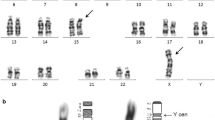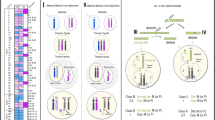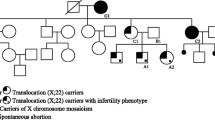Abstract
Purpose
Male carriers of an X-autosome translocation are generally infertile, regardless of the position of the breakpoint on the X chromosome while the pathogenicity of Xp22.3 subtelomeric duplications is under debate. To shed light into this controversy, we present a rare case, of an azoospermic male with no other significant clinical findings, in whom classical cytogenetics revealed additional unbalanced chromosomal material, at the telomere of the long arm of one homolog of chromosome 9.
Methods
In peripheral blood specimens of the index case and his parents, we performed GBanding, Inverted-DAPI Banding, AgNOR staining, Telomere specific Fluorescence in Situ Hybridization (FISH), Molecular karyotyping by Multi-color FISH, whole genome SNP microarrays, sub-telomeric MLPA, and transcription analysis of the expression of KAL1 gene by RT-PCR.
Results
Multi-color FISH revealed an unbalanced translocation involving the short arm of chromosome X. SNP microarray analysis combined to classical cytogenetics and MLPA demonstrated a de novo 8.796 Mb duplication of Xp22.31-p22.33. Compared to three control specimens, the patient presented significantly elevated expression levels of KAL1 mRNA in peripheral blood, suggesting transcriptional functionality of the duplicated segment.
Conclusions
The duplicated segment contains the pseudo-autosomal region PAR1 and more than 30 genes including SHOX, ARSE, STS, KAL1, and FAM9A and is not listed as polymorphic. Our data advocate that duplications of the Xp22.3 region may not be associated with a clinical consequence.


Similar content being viewed by others
References
Gardner, R.J.M., Amor, D.J. Gardner’s and Sutherland’s chromosome abnormalities and genetic counseling. 5th edition. Oxford: monographs on medical Genetics; 2018.
Baptista J, Mercer C, Prigmore E, Gribble SM, Carter NP, Maloney V, et al. Breakpoint mapping and array CGH in translocations: comparison of a phenotypically normal and an abnormal cohort. Am J Hum Genet. 2008;82:927–36.
Warburton D. De novo balanced chromosome rearrangements and extra marker chromosomes identified at prenatal diagnosis: clinical significance and distribution of breakpoints. Am J Hum Genet. 1991;49:995–13.
Madan K. Balanced structural changes involving the human X: effect on sexual phenotype. Hum Genet. 1983;63:216–21.
Worley KC, Lindsay EA, Bailey W, Wise J, McCabe ER, Baldini A. Rapid molecular cytogenetic analysis of X-chromosomal microdeletions: fluorescence in situ hybridization (FISH) for complex glycerol kinase deficiency. Am J Med Genet. 1995;57:615–9.
Lanasa MC, Hogge WA. X chromosome defects as an etiology of recurrent spontaneous abortion. Semin Reprod Med. 2000;18:97–103.
Kalz-Fuller B, Sleegers E, Schwanitz G, Schubert R. Characterization, phenotypic manifestations and X-inactivation pattern in 14 patients with X-autosome translocations. Clin Genet. 1999;55:362–6.
Fraccaro M, Maraschio P, Pasquali F, Scappaticci S. Women heterozygous for deficiency of the (p21 leads to pter) region of the X chromosome are fertile. Hum Genet. 1977;39:283–92.
Ma S, Yuen BH, Penaherrera M, Koehn D, Ness L, Robinson WICSI. The transmission of X-autosomal translocation: a three-generation evaluation of X;20 translocation: case report. Hum Reprod. 2003;18:1377–82.
Theisen A, Shaffer LG. Disorders caused by chromosome abnormalities. Appl Clin Genet. 2010;10:159–74.
Palka C, Alfonsi M, Morizio E, Soranno A, La Rovere D, Matarrelli B, et al. Array-CGH characterization of a prenatally detected de novo 46,X,der(Y)t(X;Y)(p22.3;q11.2) in a male fetus. Eur J Med Genet. 2011;54:333–6.
Stankiewicz P, Pursley AN, Cheung SW. Challenges in clinical interpretation of microduplications detected by array CGH analysis. Am J Med Genet A. 2010;152a:1089–100.
Liu P, Erez A, Nagamani SC, Bi W, Carvalho CM, Simmons AD, et al. Copy number gain at Xp22.31 includes complex duplication rearrangements and recurrent triplications. Hum Mol Genet. 2011;20:1975–88.
Esplin ED, Li B, Slavotinek A, Novelli A, Battaglia A, Clark R, et al. Nine patients with Xp22.31 microduplication, cognitive deficits, seizures, and talipes anomalies. Am J Med Genet A. 2014;164A:2097–103.
Li F, Shen Y, Kohler U, Sharkey FH, Menon D, Coulleaux L, et al. Interstitial microduplication of Xp22.31: causative of intellectual disability or benign copy number variant? Eur J Med Genet. 2010;53:93–9.
Quintela I, Fernandez-Prieto M, Gomez-Guerrero L, Resches M, Eiris J, Barros F, et al. A 6q14.1-q15 microdeletion in a male patient with severe autistic disorder, lack of oral language, and dysmorphic features with concomitant presence of a maternally inherited Xp22.31 copy number gain. Clin Case Rep. 2015;3:415–23.
Howell WM, Black DA. Controlled silver-staining of nucleolus organizer regions with a protective colloidal developer: a 1-step method. Experientia. 1980;36:1014–5.
McGowan-Jordan J, Simons A, Schmid M. ISCN 2016 An international system for human cytogenomic nomenclature, editors. Basel, Freiburg: Karger; 2016.
del Castillo I, Cohen-Salmon M, Blanchard S, Lutfalla G, Petit C. Structure of the X-linked Kallmann syndrome gene and its homologous pseudogene on the Y chromosome. Nat Genet. 1992;2:305–10.
Sowińska-Seidler A, Piwecka M, Olech E, Socha M, Latos-Bieleńska A, Jamsheer A. Hyperosmia, ectrodactyly, mild intellectual disability, and other defects in a male patient with an X-linked partial microduplication and overexpression of the KAL1 gene. J Appl Genet. 2015;56:177–84.
Alperin ES, Shapiro LJ. Characterization of point mutations in patients with X-linked ichthyosis. Effects on the structure and function of the steroid sulfatase protein. J Biol Chem. 1997;272:20756–63.
Benito-Sanz S, Belinchon-Martinez A, Aza-Carmona M, de la Torre C, Huber C, Gonzalez-Casado I, et al. Identification of 15 novel partial SHOX deletions and 13 partial duplications, and a review of the literature reveals intron 3 to be a hotspot region. J Hum Genet. 2017;62:229–34.
Bick D, Curry CJR, McGill JR, Schorderet DF, Bux RC, Moore CM. Male infant with ichthyosis, Kallmann syndrome, chondrodysplasia punctata, and an Xp chromosome deletion. Am J Med Genet. 1989;33:100–7.
Ballabio A, Zollo M, Carrozzo R, Caiulo A, Zuffardi O, Cascioli CF, et al. Deletion of the distal short arm of the X chromosome (Xp) in a patient with short stature, chondrodysplasia punctata, and X-linked ichthyosis due to steroid sulfatase deficiency. Am J Med Genet. 1991;41:184–7.
Shaffer LG, Bejjani BA, Torchia B, Kirkpatrick S, Coppinger J, Ballif BC. The identification of microdeletion syndromes and other chromosome abnormalities: cytogenetic methods of the past, new technologies for the future. Am J Med Genet C Semin Med Genet. 2007;145c:335–45.
Furrow A, Theisen A, Velsher L, Bawle EV, Sastry S, Mendelsohn NJ, et al. Duplication of the STS region in males is a benign copy-number variant. Am J Med Genet A. 2011;155a:1972–5.
Thomas NS, Harvey JF, Bunyan DJ, Rankin J, Grigelioniene G, Bruno DL, et al. Clinical and molecular characterization of duplications encompassing the human SHOX gene reveal a variable effect on stature. Am J Med Genet A. 2009;149a:1407–14.
Benito-Sanz S, Aragones A, Gracia R, Campos-Barros A, Heath KE. A non-pathogenic pseudoautosomal region 1 copy number variant downstream of SHOX. Am J Med Genet A. 2011;155a:935–7.
Fukami M, Naiki Y, Muroya K, Hamajima T, Soneda S, Horikawa R, et al. Rare pseudoautosomal copy-number variations involving SHOX and/or its flanking regions in individuals with and without short stature. J Hum Genet. 2015;60:553–6.
Tropeano M, Howley D, Gazzellone MJ, Wilson CE, Ahn JW, Stavropoulos DJ, et al. Microduplications at the pseudoautosomal SHOX locus in autism spectrum disorders and related neurodevelopmental conditions. J Med Genet. 2016;53:536–47.
Bunyan DJ, Baffico M, Capone L, Vannelli S, Iughetti L, Schmitt S, et al. Duplications upstream and downstream of SHOX identified as novel causes of Leri-Weill dyschondrosteosis or idiopathic short stature. Am J Med Genet A. 2016;170a:949–57.
Valetto A, Bertini V, Michelucci A, Toschi B, Dati E, Baroncelli GI, et al. Short stature in Isodicentric Y chromosome and three copies of the SHOX gene: clinical report and review of literature. Mol Syndromol. 2016;7:19–25.
Duke VM, Winyard PJ, Thorogood P, Soothill P, Bouloux PM, Woolf AS. KAL, a gene mutated in Kallmann's syndrome, is expressed in the first trimester of human development. Mol Cell Endocrinol. 1995;110:73–9.
Klopocki E, Mundlos S. Copy-number variations, noncoding sequences, and human phenotypes. Annu Rev Genomics Hum Genet. 2011;12:53–72.
Genesio R, Mormile A, Licenziati MR, De Brasi D, Leone G, Balzano S, et al. Short stature and primary ovarian insufficiency possibly due to chromosomal position effect in a balanced X;1 translocation. Mol Cytogenet. 2015;8:50.
Kim W, Shay JW. Long-range telomere regulation of gene expression: telomere looping and telomere position effect over long distances (TPE-OLD). Differentiation. 2018;99:1–9.
Gonzalo S, Jaco I, Fraga MF, Chen T, Li E, Esteller M, et al. DNA methyltransferases control telomere length and telomere recombination in mammalian cells. Nat Cell Biol. 2006;8:416–24.
Schoeftner S, Blasco MA. A 'higher order' of telomere regulation: telomere heterochromatin and telomeric RNAs. EMBO J. 2009;28:2323–36.
Oliver-Bonet M, Benet J, Sun F, Navarro J, Abad C, Liehr T, et al. Meiotic studies in two human reciprocal translocations and their association with spermatogenic failure. Hum Reprod. 2005;20:683–8.
Roumelioti FM, Sotiriou SK, Katsini V, Chiourea M, Halazonetis TD, Gagos S. Alternative lengthening of human telomeres is a conservative DNA replication process with features of break-induced replication. EMBO Rep. 2016;17:1731–7.
Chomczynski P, Sacchi N. Single-step method of RNA isolation by acid guanidinium thiocyanate-phenol-chloroform extraction. Anal Biochem. 1987;162:156–9.
Author information
Authors and Affiliations
Corresponding author
Additional information
Publisher’s note
Springer Nature remains neutral with regard to jurisdictional claims in published maps and institutional affiliations.
Rights and permissions
About this article
Cite this article
Roumelioti, FM., Louizou, E., Karras, S. et al. Unbalanced X;9 translocation in an infertile male with de novo duplication Xp22.31p22.33. J Assist Reprod Genet 36, 769–775 (2019). https://doi.org/10.1007/s10815-019-01405-0
Received:
Accepted:
Published:
Issue Date:
DOI: https://doi.org/10.1007/s10815-019-01405-0




